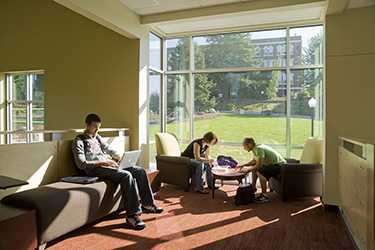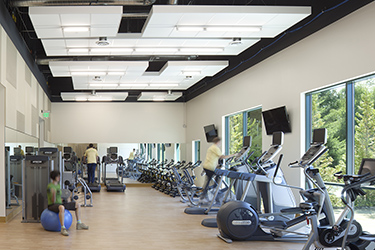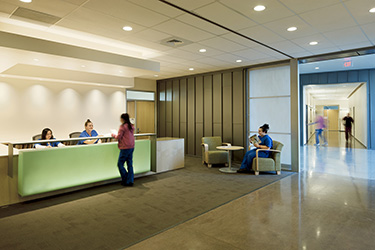|
Subscribe / Renew |
|
|
Contact Us |
|
| ► Subscribe to our Free Weekly Newsletter | |
| home | Welcome, sign in or click here to subscribe. | login |
Construction
| |
 |
July 24, 2014
Student health centers evolving to provide more holistic care
McGranahan Architects

Olson
|
Arecent posting in the Forbes education blog brought to light the dramatic growth in services provided through campus-based student health centers.
Today’s student health center has moved from a traditional clinic setting, charged solely with treating the sick and injured, to a more holistic model that also incorporates a complex series of services — including mental health, management of chronic conditions and educational outreach programs — to address the full spectrum of health and wellness.
With an increasing number of studies reporting a compelling link between a student’s overall health and academic success, colleges and universities are looking for new models that will integrate health care delivery, counseling services and recreation opportunities for their student population.
How students are different
This evolution of student health in many ways parallels the changes underway in the wider public sector, such as the introduction of the primary care medical home model and the push to develop accountable care organizations in response to the Affordable Care Act. But before inserting the latest integrated clinic model into a campus setting, the design team would be well served to take a closer look at some of the unique considerations of this population.
Statistically, the student population is significantly healthier than non-students within the same age group and the general population as a whole. There is, however, a growing segment of the college-bound population that is coping with serious conditions such as asthma, ADHD, addiction, and autism-spectrum disorders that require active management and monitoring by campus health providers.
Colleges and universities have seen an increase in international students and travel by students and faculty, introducing the opportunity for exposure to global pandemics such as the N1H1 outbreak in 2009. Classroom settings, common socializing, and close living quarters found on college campuses all contribute to the potential spread of contagious diseases. Locally, one need only look back to the swine flu outbreak in 2009 that swept through the Washington State University campus in Pullman, resulting in at least at least 2,000 students and residents becoming ill, according to The Seattle Times.
The American College Health Association, a nationwide advocate for college and university health, publishes the National College Health Assessment, an annual survey of students’ behaviors and perceptions of health topics. In their most recent survey, students were asked to identify factors affecting their individual academic performance. The three highest-ranked responses were stress, sleep difficulties and anxiety.
Behavioral health counseling and health promotion have seen an increased demand among students, although there has not yet been a unified approach to providing these services. Recent events have also brought the issues of gun violence, harassment and sexual assault into the realm of overall campus health and safety.
Changing care
For students, health and sense of well-being are important contributing factors to the quality of their educational experience.
Daniel Silverman, a physician writing in the Student Health Spectrum, notes that “Health creates capacity; students whose health status is positive and flourishing have greater ability and readiness to learn and engage fully in all meaningful educational experiences...”
To this end, many campuses have been moving from a reactive model of care, with an emphasis on clinical services, to a more responsive, holistic approach with the following characteristics:
• Interdisciplinary model that integrates counseling and health services. This methodology provides benefits to the student including continuity of care and simplified access into the system, while also providing the potential to streamline resources and eliminate duplicated efforts.
• Expanded outreach efforts and wellness promotion. The new prototype for student health places an emphasis on outreach and wellness promotion. Services being offered can range from stress reduction workshops to vaccination programs and information about eating disorders. These services are taking full advantage of online and social networking methodologies to reach beyond the traditional health clinic environment.
• Direct ties to classroom learning and student life. Many colleges are looking at innovative ways of aligning student health with other available campus resources, such as schools of nursing, public health programs and even student recreation facilities.
Design considerations
While current best practices for the delivery of ambulatory care services are applicable in student health settings, a successful design response should also consider the following elements:
Access: Today’s students are fully immersed in the digital world, and campus health services should be prepared to interact on various social media platforms as well as in a physical setting. The center should be welcoming and easily identifiable within the larger campus setting.
Privacy: Confidentiality is one of the top concerns identified by students utilizing campus health services. Where primary care and counseling services have been integrated into a single facility, the design team should work closely with these users to understand how the check-in, waiting and rooming process will address student privacy and comfort.
Integration: Today we are seeing an innovative merging of services and campus resources around the concept of health and wellness for students and faculty. Primary care physicians and nurses are working alongside behavioral health counselors, nutritionists, massage therapists and medical researchers.
As these divergent elements are brought together, collaborative staff spaces should be incorporated into the design, much as the care team space has been incorporated into the medical home clinic model. There may also be opportunities to streamline shared support spaces and functions in this integrated setting.
Flexibility: The student health center should be able to respond to variations in services that will occur throughout the school year: wellness promotions or seminars, vaccination clinics, a spike in flu cases. Beyond the ability to handle a flexible calendar of events, the student health center may be asked to play a central role in disaster preparedness on campus and potentially for the surrounding community.
Young adults beginning their college experience are asked to manage their personal health care decisions with little or no parental oversight. These students are making decisions and forming habits that will shape their well-being throughout their lifetimes.
The opportunity to design health care facilities that engage students and provide the necessary resources to make informed choices is one that architects and engineers should eagerly embrace.
Todd Olson brings nearly 30 years of programming, planning and design experience in health care and educational environments to McGranahan Architects.
Other Stories:
- How lean helped hyper-fast project to cross the finish line
- Seattle Children’s psychiatry unit will help kids feel at home
- What’s next for the UW medical center
- Behavioral health projects present unique challenges
- How to design and build a plastic surgery center in less than 5 months
- Hospitals have a lot to learn from lean
- You can protect patients with clean construction





